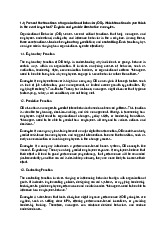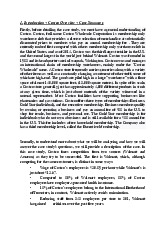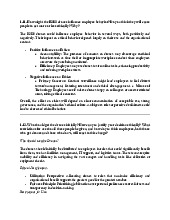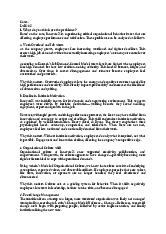





Preview text:
lOMoAR cPSD| 58591236 Exam Date:19/11/2020
What is the relationship between performance norms, cohesiveness and group productivity?
The relationship between performance norms, cohesiveness, and group productivity is
interrelated and can significantly impact the effectiveness of a group. Here's how these factors relate to each other: Performance Norms:
Performance norms are shared expectations within a group regarding the level of performance
and the quality of work expected from its members. These norms influence the standards and
benchmarks against which individual and collective performance is evaluated. Performance
norms can be explicit (formally communicated) or implicit (developed through observation and interaction). Cohesiveness:
Cohesiveness refers to the degree of unity, camaraderie, and interpersonal attraction among
group members. It reflects the extent to which individuals feel connected to the group and share
a sense of belonging. Cohesiveness is influenced by factors such as shared goals, positive
relationships, and group processes that promote collaboration. Group Productivity:
Group productivity refers to the collective output, efficiency, and performance of a group in
achieving its objectives or completing tasks. It reflects the combined efforts and effectiveness of
group members in working together towards a common goal. The Relationship:
Performance norms, cohesiveness, and group productivity are interconnected in the following ways:
1. Influence of Performance Norms on Group Productivity:
Performance norms can directly influence group productivity. When performance norms are high
and emphasize excel ence, members are more likely to strive for higher levels of performance
and output. Clear expectations and standards set by performance norms can motivate group
members to perform at their best, leading to improved productivity.
2. Impact of Cohesiveness on Group Productivity:
Cohesiveness has a positive impact on group productivity. When group members feel a sense of
belonging, trust, and camaraderie, they are more likely to collaborate effectively and support
one another. Cohesive groups tend to have better communication, cooperation, and coordination,
which can enhance productivity.
3. Influence of Performance Norms on Cohesiveness:
Performance norms can shape the cohesiveness of a group. When performance norms are clear
and high, they can create a shared understanding and commitment among group members.
Members may develop a sense of cohesion as they strive together to meet or exceed performance expectations. lOMoAR cPSD| 58591236
4. Impact of Cohesiveness on Performance Norms:
Cohesive groups tend to develop and maintain their own performance norms. As group members
interact and collaborate, they establish informal rules and expectations regarding performance.
This can reinforce positive performance norms, as group members hold each other accountable
and strive to meet the shared standards.
It's important to note that the relationship between performance norms, cohesiveness, and group
productivity is complex and can be influenced by various other factors, such as leadership, task
characteristics, and individual motivation. Additionally, it's essential to maintain a balance
between high-performance expectations and a supportive, cohesive group environment to
maximize productivity while ensuring member satisfaction and wel -being.
How do job designs influence motivation? (Trong sach chi co 5 cai factors dau)
Job design refers to the way tasks, responsibilities, and roles are organized within a job. It plays
a crucial role in influencing employee motivation. Different job design approaches can impact
motivation in various ways. Here are some key factors: 1.
Skil Variety: Jobs that offer a variety of tasks and require diverse skil s can enhance
motivation. When employees can utilize a range of skil s and abilities, they experience a sense of
chal enge, personal growth, and achievement. 2.
Task Identity: Jobs that provide employees with a clear sense of the whole task and its
outcome can increase motivation. When individuals can see the tangible results of their work and
feel a sense of ownership, it enhances their motivation and engagement. 3.
Task Significance: Jobs that have a meaningful impact on others or the organization can
increase motivation. When employees perceive that their work contributes to something larger
and makes a difference, it provides a sense of purpose and fulfil ment. 4.
Autonomy: Jobs that allow employees to have a certain level of autonomy and
decisionmaking authority can enhance motivation. When individuals have the freedom to make
choices, take ownership of their work, and have a say in how tasks are accomplished, it fosters a
sense of responsibility and motivation. 5.
Feedback: Jobs that provide regular and constructive feedback on performance can
enhance motivation. Feedback helps individuals understand their progress, identify areas for
improvement, and feel acknowledged for their efforts. It allows them to adjust their work and stay
motivated to achieve their goals. 6.
Task Complexity: Jobs that provide chal enging and intellectually stimulating tasks can
enhance motivation. When employees are intellectually engaged and have opportunities to learn
and grow, it increases their motivation and job satisfaction. 7.
Goal Setting: Jobs that incorporate clear and meaningful goals can enhance motivation.
When employees have specific, measurable, achievable, relevant, and time-bound (SMART) lOMoAR cPSD| 58591236
goals, it provides a sense of direction and focus. Goal setting helps individuals stay motivated
and strive for accomplishment. 8.
Social Interactions: Jobs that promote positive social interactions and collaboration can
enhance motivation. When employees have opportunities to work with others, share knowledge,
receive support, and experience a sense of camaraderie, it can increase motivation and job satisfaction. 9.
Rewards and Recognition: Jobs that offer appropriate rewards and recognition for
performance can enhance motivation. Rewards can be in the form of financial compensation,
promotions, opportunities for growth, or non-monetary recognition. When employees feel valued
and rewarded for their efforts, it boosts motivation and engagement.
It's important to note that individuals have diverse motivational needs and preferences. Job
designs should take into account individual differences and align with employees' intrinsic
motivations, interests, and values to foster a positive motivational climate. Flexibility in job
design, where possible, can help accommodate individual needs and increase motivation. Exam Date: 26/11/2021
How does equity theory explain motivation and behavior, and how equity theory be used
to diagnose and improve employee motivation
Equity theory, developed by J. Stacy Adams, explains motivation and behavior by focusing on the
concept of fairness and equity in the workplace. It suggests that individuals are motivated when
they perceive a fair balance between the inputs (e.g., effort, skil s, experience) they contribute to
their work and the outcomes (e.g., salary, recognition, benefits) they receive in return. Here's
how equity theory explains motivation and behavior: 1.
Perceived Equity: According to equity theory, individuals strive to achieve a state of
perceivedequity, where they feel that their inputs and outcomes are fairly balanced compared to
others. When employees perceive equity, they experience a sense of fairness and motivation. 2.
Inequity: Inequity occurs when individuals perceive an unfair distribution of inputs and
outcomes in comparison to their referent others (e.g., colleagues, peers). Inequity can lead to
feelings of under-reward or over-reward. 3.
Tension and Motivation: When individuals perceive inequity, it creates a state of tension
or cognitive dissonance. This tension motivates them to restore a sense of equity by either
adjusting their inputs, outcomes, or changing their referent others. 4.
Behavioral Responses: Equity theory suggests that individuals can respond to perceived inequity in several ways: -
Change Inputs: Individuals may reduce their effort, commitment, or contributions to
restore a sense of equity if they feel they are over-contributing compared to others. -
Change Outcomes: Individuals may seek additional rewards, recognition, or benefits to
achieve equity if they perceive they are under-rewarded compared to others. lOMoAR cPSD| 58591236 -
Change Referent Others: Individuals may change their comparison group or shift their
perceptions of who they consider as relevant comparisons to restore equity. -
Leave the Situation: If inequity persists and efforts to restore equity are unsuccessful,
individuals may choose to leave the organization or seek alternative employment opportunities.
Using Equity Theory to Diagnose and Improve Employee Motivation: 1.
Conduct Equity Assessments: Organizations can use surveys or feedback mechanisms
to assess employees' perceptions of fairness and equity. This can help identify potential
inequities and areas for improvement. 2.
Enhance Communication and Transparency: Organizations should communicate clearly
about the criteria used for rewards, promotions, and decision-making processes. Transparent
communication fosters a sense of fairness and reduces perceptions of inequity. 3.
Provide Fair Performance Evaluation: Ensure that performance evaluations and reward
systems are fair, consistent, and transparent. This includes providing feedback, recognizing and
rewarding performance based on objective and equitable criteria. 4.
Offer Opportunities for Input: Involve employees in decision-making processes and
provide opportunities for them to have a voice in matters that affect them. This promotes a sense
of ownership and fairness in organizational processes. 5.
Promote a Culture of Equity: Foster a culture that values and promotes fairness, diversity,
and inclusivity. Encourage open dialogue, address grievances promptly, and ensure that policies
and practices are consistently applied. 6.
Address Inequities: If inequities are identified, take proactive steps to address them by
adjusting compensation, workload distribution, or opportunities for growth and development.
By understanding equity theory and applying its principles, organizations can diagnose and
address motivational issues related to fairness, promote a positive work environment, and
enhance employee motivation and satisfaction.
Describe an organizational culture of a specific organization that you know? How are
culture values transmitted through rituals stories, symbols
Let's consider a fictional technology company called "Tech Innovators Inc." that values creativity,
collaboration, and innovation. Here's how their culture values might be transmitted: 1.
Rituals: Tech Innovators Inc. may have regular rituals that promote collaboration and
creativity. For example, they could have weekly "Innovation Jam" sessions where employees
gather to brainstorm and share ideas. These sessions may have a structured format, such as
design thinking workshops or hackathons, to encourage innovative thinking and problemsolving. lOMoAR cPSD| 58591236 2.
Stories: Within Tech Innovators Inc., employees may share stories that highlight
successful projects, innovative solutions, or instances where individuals went above and beyond
to solve complex problems. These stories serve as a way to inspire and reinforce the importance
of creativity and innovation in the organization's culture. 3.
Symbols: Symbols can play a crucial role in expressing and reinforcing organizational
culture.Tech Innovators Inc. may have symbols such as a logo that represents their commitment
to innovation and cutting-edge technology. The office space might be designed to promote
collaboration, with open work areas, innovation hubs, and colorful artwork that reflects the company's values. 4.
Language and Communication: The language used within the organization can reflect
and reinforce its culture values. Tech Innovators Inc. may have specific terminologies or jargon
that represents their commitment to creativity and innovation. For instance, they might use
phrases like "out-of-the-box thinking" or "disruptive solutions" in their communication to
emphasize their cultural values. 5.
Leadership Behaviors: The behavior of leaders within Tech Innovators Inc. plays a crucial
role in transmitting culture values. Leaders who demonstrate and promote creativity,
collaboration, and innovation through their actions, decisions, and interactions with employees
contribute to shaping the organizational culture.
These examples illustrate how organizational culture values can be transmitted through various
means, including rituals, stories, symbols, language, and leadership behaviors. It's important to
note that each organization's culture is unique, and the specific values and practices wil vary
based on the organization's mission, industry, and context.
Select a group which you know well or you are a member of. Answering the following questions:
What is your group’s size,composition,function, and status?
How do these factors affect its operations and outcomes?
What formal rules and informal norms does the group use to control its member’s behavior?
Group: Project Team in a Software Development Company
Size: The size of the project team can vary depending on the scale and complexity of the project.
It could range from a small team of 5-10 members to a larger team consisting of 20 or more individuals.
Composition: The composition of a project team typically includes individuals with different roles
and expertise, such as software developers, designers, testers, project managers, and other
relevant stakeholders. The team members may have different levels of experience and skil s.
Function: The primary function of a project team in a software development company is to
collaborate and work together to achieve specific project goals. This involves tasks such as lOMoAR cPSD| 58591236
requirement analysis, software design, coding, testing, and deployment. The team's purpose is to
deliver high-quality software products or solutions to meet client requirements and expectations.
Status: The status of the project team can vary based on the project's progress and the team's
overall performance. A team may be in the initial stages of a project, actively developing
software, or nearing project completion. The status may also be influenced by factors such as
budget, client satisfaction, and the team's ability to meet deadlines.
How these factors affect operations and outcomes: -
Size and composition: The size and composition of the team impact how tasks are
allocated, communication flows, and the level of collaboration. Larger teams may require more
coordination efforts, while smaller teams may have a more streamlined decision-making process.
The diversity of skil s and expertise within the team can contribute to a more wel rounded approach to problem-solving. -
Function: The specific function of the project team, such as software development,
influences the methodologies, tools, and processes employed. Agile methodologies like Scrum
or Kanban might be used to manage the team's work, while development frameworks and
programming languages wil affect the technical implementation. The team's function also
determines the interactions with clients, stakeholders, and other teams within the organization. -
Status: The current status of the project team affects the urgency, prioritization, and
resource allocation within the team. It can influence the level of stress, motivation, and
teamwork. For example, a team under time pressure may need to adjust their processes and
allocate more resources to meet deadlines, potentially affecting the quality of outcomes.
Formal rules and informal norms: -
Formal rules: Project teams often have formal rules that govern their behavior and
conduct. These can include guidelines for project management, reporting structures, time
tracking, quality standards, and compliance with company policies. Formal rules provide
structure, ensure consistency, and help manage the team's activities. -
Informal norms: In addition to formal rules, project teams develop their own informal
norms and standards over time. These can include unwritten expectations, communication
preferences, and approaches to problem-solving. Informal norms shape the team's culture,
decision-making processes, and overall dynamics. For example, team members may establish
norms for prompt response to emails or regular status updates.
Both formal rules and informal norms play a role in controlling members' behavior and fostering a
productive team environment. They contribute to establishing expectations, promoting
accountability, and ensuring effective collaboration among team members.




